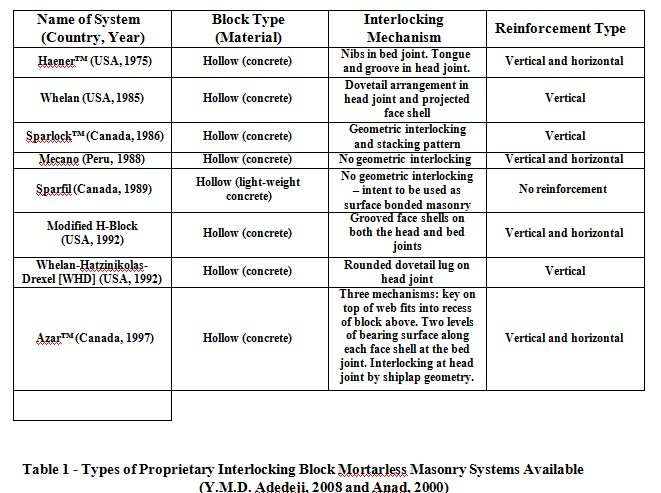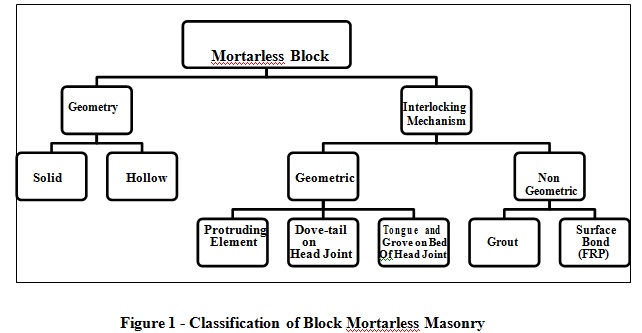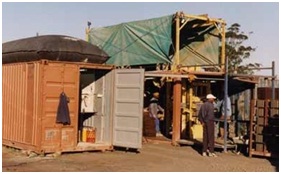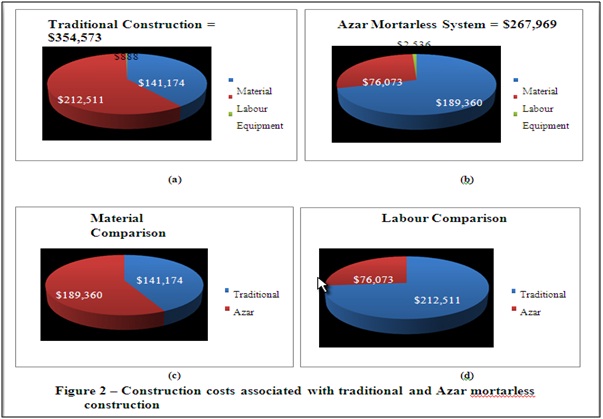





Published on Nov 30, 2023
In developing countries masonry is still the most prevalent housing material, while a renewed interest in the developed world has helped transform this ancient system into an innovative engineering material with a variety of structural applications. Due to the time-critical nature of the modern construction industry, there is a need to improve upon traditional masonry construction methods, which are labour and time intensive. The pursuit of this has led to the development of several nonconventional methods of masonry construction, including a variety of mortarless systems.
This seminar report will explore the design and construction aspects of mortarless masonry construction in comparison to traditional methods. An overview is presented for the evolution of new techniques and advancements in the masonry field, in addition to the different mortarless applications for various countries. Furthermore, a detailed classification of mortarless masonry systems is offered, along with a review of the behavior of some of these systems. A cost comparison between traditional construction and a mortarless system indicates a reduction in labour costs and construction time, which validates this new trend as a cost-effective alternative.
The demand of houses for low to medium income population of the world has exceeded more With the increase of construction materials costs such as cement, steel and timber, contractors are not enthusiastic to build these houses on a tight budget. The construction method of using conventional bricks has been revolutionized by the development and usage of interlocking concrete masonry units and lightweight concrete blocks. The tedious and time-consuming traditional brick-laying tasks are greatly simplified by the usage of these effective alternative solutions.
Masonry performs simultaneous functions of carrying load and enclosing space, while possessing strong properties for fire resistance, thermal and sound insulation and protection against environmental exposure. As a result, masonry is a cost-effective and low-energy alternative when designed appropriately. However, its main shortcoming is that its construction is slow and labour intensive. Furthermore, conventional masonry construction, especially for smaller units, leads to a large number of mortar joints. In order to limit the stresses induced in these joints during construction, the rate at which the height of a wall increases in somewhat restricted.
The introduction of interlocking mortarless masonry has led to a large increase in field productivity and efficiency, as well as a reduction in the requirements for highly specialized labour crews. This paper will present a literature review of interlocking mortarless masonry construction and its inherent advantages in building construction
The interlocking blocks are different from conventional bricks since they do not require mortar to be laid during bricklaying work. Because of this characteristic, the process of building walls is faster and requires less skilled labour as the blocks are laid dry and lock into place. Concrete blocks may be produced with hollow centers to reduce weight, avoid seepages or improve insulation. The holes inside the concrete block allow rebar and concreting (creating reinforced concrete) to run vertically through the block to compensate for the lack of tensile strength. Rebar used can be of mild steel instead of the usual higher grade steel. Once a section of wall is built, grout holes are filled with a lean cement mixture to seal the wall and making a permanent solid wall. The amount of grout used was calculated to be less than 7.5% of the mortar used in conventional masonry.
• Since the blocks can be laid dry, no mortar is required and a considerable amount of cement is saved.
• Each block has vertical holes, which serve four purposes:
1. To reduce the weight of the block,
2. To insert steel rods or treated kenaf bar for reinforcement,
3. To act as conduit for electrical and water piping,
4. To pour liquid mortar (grout) into the holes, which run through the full height of the wall, thus increasing its stability and providing barrier to seepages.
• The length of each block is exactly double its width, in order to achieve accurate alignment of blocks placed at right angles; else, a junction block is required.
Individual blocks are generally the same size as a typical 200 x 200 x 400 mm concrete masonry block, but each system is unique (Murray 2007). Table 1 outlines several of the most notable mortarless systems that have been proposed. Depending on the application, one system may provide more advantages than another. For example, lintel beams spanning over a door or window opening will require a block suitable for horizontal reinforcement. As it can be seen from table 1, only some systems provide both horizontal and vertical reinforcement capabilities.

Currently in the world several types of mortarless blocks have been proposed including those that are of interlocking geometry. Most of these are hollow; however, solid interlocking blocks have also been developed as an improvement over the traditional adobe bricks that were prevalent in some African countries during the 20th century.

The Haener block has been on the market longer than any other mortarless system. The webs of the units have raised lugs, which are offset in such a way that they interlock with the courses above and below. One practiced laboure can stack more than 80 blocks in an hour as compared with 40 in an hour from the combined efforts of a laboure and a mason in conventional masonry construction (i.e. 20 per worker per hour). It is the responsibility of the installer to address the issues that arise from variable block heights. It is common practice to plumb the wall through the use of shims such as brick ties or incorporating a layer of mortar every four courses. The Haener system is grouted and reinforced as required, comparable to traditional masonry.
Relatively new to the industry, Azar blocks interlock along both the bed and head joints through a mechanism that resembles a tongue and groove system. Walls are completed using a combination of stretcher and corner blocks and an unskilled labourer can stack up to 100 blocks per hour. The assembled wall is adjusted to plumb using temporary bracing as required and fully grouted to lock the units in place. As a fully grouted system, it requires more grout than conventional masonry in approximately 95% of applications.
Sparlock is a Canadian-based mortarless masonry unit developed in the early 1980’s. Over the years of research and development, the product has become well established in the North American market. More recently, Sparlock blocks have added to their marketing strategies and become recognized in the housing market of developing nations. The Sparlock Empowerment Program is based on the idea of being able to set up a third world community with the tools and knowledge to be self-sufficient. Sparlock is able to create a mobile production site out of a standard sized shipping container Steel moulds provide a reusable tool to make the mortarless blocks from local materials.

Instructors educate local residents so they are capable of assembling their own residences without any special trades. No mortar joints are required; therefore, the amount of skilled labour that is necessary is drastically reduced. The walls for an 85 m2 (900 ft2) house with finished window and door frames may be easily erected by a small work crew in one day (Sparlock, 2010).
For conventional masonry, the requirement for mortar at the head and bed joints of each block necessitates a larger amount of time and skill in construction. Furthermore, time required for mortar bed curing restricts the height of a wall that may be built in a given day due to the self- weight of the constructed masonry. Therefore, it can be appreciated that the elimination of bedding mortar will accelerate construction, thereby reducing cost and variation due to workmanship. In addition, some other advantages of mortarless construction are:
• Blocks can be laid much easier with less technical skill.
• Decreased risk of moisture damages and shrinkage.
• More stability during construction (especially for interlocking blocks) compared with
Conventional masonry because the blocks do not “swim” in mortar.
• Walls can be loaded immediately after construction.
• Masonry can be assembled in any weather conditions (i.e. winter season).
In a study done by Ramamurthy and Nabiar in 2004, it was found that the rate of construction can be accelerated significantly. The laboratory experiment involved the construction of 1400 mm square panels from both conventional block masonry and Whelen interlocking block masonry. Test results showed that the completion time for the conventional masonry was 3.5 hours with a crew of one person, whereas the time spent for the Whelan blocks was 1.25 hours. This indicates that the production rate for the mortarless system is approximately 4.1 m2 per hour, which is 2.5 times that of the traditional system. Manufacturers of Haener blocks state that their system allows blocks to be laid up to five times faster than conventional block masonry, creating labour savings up to 80%. With the Azar system, the Azar group reports that unskilled workers can stack 100 blocks each per hour, compared with approximately 30 to 40 blocks per hour for a crew of three masons and one helper for conventional masonry.
In several studies, it was found that a set mortar was required at the base of a wall in order to facilitate wall leveling and aligning for the first course. Thereafter, the blocks themselves must be manufactured with increasingly high standards and tight tolerance such that the wall will maintain plumb during construction. Current physical tolerances for mortarless concrete units are limited to ± 1.6 mm (1/16 in) which precludes the need for mortaring, grinding of face shell surfaces, or shimming to even out courses during construction.
It is rather difficult to enumerate the main disadvantages of mortarless block since each system has inherent advantages and disadvantages associated with its design; however, a general disadvantage list for the majority of units is as follows:
• Relatively high initial settlement.
• Challenges in controlling the height of the units to achieve accurate running bond.
• Difficulty in keeping grooves from breaking during transportation and construction.
• In running bond pattern, plain interlocking units without grouting have little resistance to vertical bending.
• In stack bond pattern, plain interlocking units without grouting have little resistance to horizontal bending.
The primary advantages of mortarless masonry are the expediency of construction and reduced labour costs. In order to validate these claims, a cost analysis is contained herein for the Azar Mortarless Building System in comparison with traditional masonry construction. A typical commercial structure in Edmonton, Alberta is used as the basis for comparison, with dimensions of 15 m x 40 m x 4 m (W x L x H) for the building envelope. The wall is reinforced with 20M vertical bars at 600 mm spacing. While the traditional construction only requires grout every third core to correspond with the reinforcement, the Azar system must be fully grouted as indicated during the previous discussion of the system. Three masons and one labourer are required to stack and mortar the conventional wall, while one mason leads a crew of three labourers for the Azar system. The rates of production for these two crews are approximately 30 blocks per hour and 300 blocks per hour, respectively (Azar Mortarless Building Systems, 2010). The remaining cost and production values used in the analysis are based on information from RS Means 2009 and the detailed breakdown is included in Appendix I. Figure 2 illustrates the total costs associated with each type of construction.

The material costs for the mortarless system actually exceed those of traditional construction due to the higher cost for the units themselves and the larger quantity of grout. However, the 64% reduction in labour costs more than compensates for this. Additionally, the duration of the construction is reduced from 1377 hours (34.4 weeks) for conventional masonry to 505 hours (12.6 weeks) for the Azar Block wall. Depending on the nature of the project, this offers potential for additional monetary gains from a structure that is operational at an earlier date.
The FlexLock Wall System, developed by Cercorp Initiatives, was chosen as the primary building material for a project in Magnolia, Texas in order to study the benefits of mortarless blocks. The scope of work for the project consisted of a 275 m2 (2,958 ft2) house with construction starting in June 2006 (Cercorp Initiatives, 2010). The project consisted of all of the standard elements included within a typical masonry structure: lintels, jambs, sills, and bond beams. This provided a comprehensive comparison with conventional masonry units.

The FlexLock Wall System is comprised of interlocking, mortarless masonry units. The blocks are similar to other products with interlocking mechanisms at both the bed and head joints, but the manufacturer recommends that the walls be post-tensioned. This increases the structural capacity of the wall, eliminates the need for grout, and reduces the amount of initial settlement. Figure 3 depicts a wall of the house being post-tensioned.
At the time of construction, the Magnolia region had an average installed price of roughly $75 per m2 for conventional masonry units. After breaking down the cost of the FlexLock System project, the price came to $57.24 per m2 (Cercorp Initiatives, 2010). This is a reduction of 24% in installed cost. The labour crews were inexperienced with the mortarless product, yet were still capable of stacking blocks at an average rate of 164 blocks an hour. When compared to conventional masonry, this is an increase in productivity of over 100%.
Serving as the model for the masonry design standards in many other countries, the United States code covers analysis and design for strength and serviceability, as well as construction of masonry structures. It also includes a chapter on prestressed masonry. The American industry has made a move towards limit states design, but working (allowable) stress design is still widely practiced. In Canada, the code for the design and construction of masonry buildings is regulated by the Canadian Standard Association (CSA) and the current edition is CSA S304.1-04.However, mortarless masonry construction is not specifically addressed in these codes and standards due to the relatively short history of the available systems.
The Eurocode and accompanying product standards define standard testing procedures and calculation methods. The determination of mechanical characteristics of masonry through adequate testing methods is essential in verifying the load bearing capacity and stability of masonry structures (Tomaževič, 2009).
Development of codes and standards for masonry construction was not a priority in Latin American countries until masonry started to be re-evaluated roughly 25 years ago. Most masonry codes, as is the case with reinforced concrete and other structural materials, are adaptations of existing codes in the United States, primarily the Uniform Building Code (UBC).The design provisions in Chile’s code for reinforced masonry and confined masonry design provisions are based on allowable stress design, but some limit states concepts have also been utilized. Design of reinforced concrete block masonry in this code is similar to that in the UBC, but a special variation on the shear strength of hollow clay brick masonry has been introduced to prevent cracking under moderate earthquakes.
According to the Complementary Technical Norms for Design and Construction, Mexican masonry regulations were updated after the Mexico City earthquake in 1985. Unlike most Latin American countries, current Mexican design provisions are based on Limit States Design like the Canadian Code.
Growing awareness for environmental health has become increasingly prevalent in recent years. At a global level, leaders are looking for ways to contribute towards making the planet a better place. Leadership in Energy and Environmental Design (LEED) evolved as a response to environmental concerns in order to encourage sustainable design. Established by the US Green Building Council in 1998, the organization has grown to become adopted by 30 countries as a standard rating system for building design (ICPI, 2005). During the design phase, a building applies to become a “LEED Certified Building” through the design team. As part of the development process, certain aspects of the design are evaluated for the number of LEED credits that can be earned.
Based upon the total number of credits achieved, the building is awarded a status of Certified, Silver, Gold, or Platinum. Having a higher level of certification will have greater initial costs, usually due to higher levels of technical systems or specialized materials, but the increased levels of efficiency result in lower operation and maintenance fees. Additionally, government programs or regional sponsors have been known to offer grants for the completion of a more environmentally friendly building.
Interlocking mortarless masonry may help contribute to a building’s LEED status over and above the use of mortar-jointed masonry through two different ways. LEED has potential credit opportunities for “Innovation in Design;” if successful in achieving this, interlocking masonry would gain one additional credit. The intent of the credit is defined as (USGBC, 2005).
“Provide design teams and projects the opportunity to be awarded points for exceptional performance above the requirements set by the LEED Green Building Rating System and/or innovative performance in Green Building categories not specifically addressed by the LEED Green Building Rating System.”
For the specific innovative application of mortarless masonry, this credit may be awarded based on varying interpretations of its contribution to sustainable design. Construction processes often have an environmental impact through increased pollution: the use of vehicles, equipment, and possibly heaters can add up to a significant amount depending on the project.
By greatly increasing the efficiency of the construction, the amount of pollution can be kept to a minimum.
Another interpretation could be that the overall amount of material used on the project has decreased. Mortar is usually a composition of Portland cement, water and sand. Portland cement production creates emissions that have proven to be harmful to the environment. By not requiring any mortar at all, the project has decreased pollution. For either interpretation, the larger the project is, the more significant the impact is on sustainability.
Interlocking mortarless masonry systems have been competing successfully against reinforced concrete in North America for years. Based on the market demand for efficiency in the construction process, one of the main limitations of the traditional procedure is that it is slow and labour intensive. In utilizing interlocking units without mortar, an unskilled crew with appropriate guidance can place more units in a given period of time. The combination of higher productivity and a less expensive labour force reduces labour costs significantly. A cost comparison revealed these potential savings to more than outweigh the additional material costs associated with interlocking units, and this was validated with a comprehensive case study.
The current editions of the National Building Code of Canada and the Canadian masonry design standard do not directly address mortarless masonry and this trend is reflected internationally as well. However, results from empirical testing can be used to validate the application of existing codes and standards. The onus is generally on the manufacturers of the various systems to provide guidance to the designer and ensure that their product conforms to regional regulations. The Azar™ Building Systems Company has gone through this process in Canada, and comparative design examples revealed the strength of this mortarless system to exceed that obtained from a conventional masonry wall.
For all its advantages, mortarless masonry is not without its limitations and it is not suitable for every project. However, there is a great deal of unrealized potential for this type of construction. In the appropriate applications, mortarless masonry has shown itself to be a cost- effective and viable alternative to conventional construction methods
1. Design and construction of interlocking mortarless block masonry J. Edwards, M. Gayed, M. Pyra and T. Rodriguez department of civil and environmental engineering university of Alberta. This report was submitted on 2 April 2010 of Masonry chair report no. 1012010.
2. Sustainable Housing Using an Innovative Interlocking Block Building System by Nasly M.A and AAM Yassin Prof.,PhD.School of civil engineering, School of petroleum engineering University Teknologi Malaysia, 81300 Skudai, Johor, MALAYSIA. Tel: 07-5531624Fax: 07-5566157 which was submitted in Meniti Pembangunan Lestari dalam Kejuruteraan Awam, 2009 Pusat Pengajian Kejuruteraan Awam, Universiti Sains Malaysia.
3. Azar Dry-Stack Block™ CCMC 12873-R evaluation report division 04226 Re-evaluation 2004-08-10 National Research Council Canada.
4. CMHC Approval report for SPARLOCK national research consil canada CCMC-12268-R.
5. Sustainable Construction Using Inter- Locking Bricks/Blocks M. Sai Sharath, v. venkata vikas, b. sarath chandra kumar. ISSN 2320 – 3439, Vol. 02, No. 01, January 2013, pp. 06 – 10
| Are you interested in this topic.Then visit the below page to get the full report |